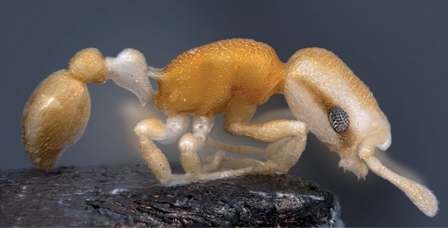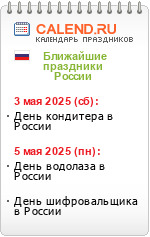01:39 Cardiocondyla pirata sp. n. - новый вид муравья с необычной пигментацией тела, напоминающей повязку пиратов через глаз | |
Cardiocondyla pirata sp. n. – a new Philippine ant with enigmatic pigmentation pattern (Hymenoptera, Formicidae) Bernhard Seifert, Sabine Frohschammer ZooKeys. 2013. 301: 13–24, doi: 10.3897/zookeys.301.4913. Published 17 May 2013 РЕФЕРАТ. Из Филиппин описан новый для науки и очень необычно окрашенный муравей из рода Cardiocondyla Emery, 1869 – Cardiocondyla pirata sp. n. Этот мелкий муравей (длина тела около 1 - 2 мм) принадлежит к Индо-малайской группе из 6 видов is characterized by workers having a strongly bilobate postpetiolar sternite and a thickset mesosoma with strongly convex dorsal profile as well as wingless, ergatoid males with sickle-shaped mandibles. The female castes show a pigmentation pattern not known from any ant worldwide. If having any adaptive value, a possible function of this structure is supposed to be visual dissolution of body shape in order to irritate predators. Адаптивной значение такой необычной пигментации тела остается неясным.  (C) 2013 Bernhard Seifert. Creative Commons Attribution License 3.0 (CC-BY) ВВЕДЕНИЕ. 105 валидных названий видов зафиксировано в составе рода Cardiocondyla Emery, 1869 and 68 of these are currently considered to designate bona species (Bolton 2012). While there is a rather good taxonomic knowledge of the species groups distributed in the Palaearctic (Seifert 2003), the situation in the Oriental, Indo-Malayan and Australasian faunal regions is poorly known. This is indicated by the fact that there is a minimum of 15 morphologically well-separated, but yet undescribed species from this region in the collection of the Senckenberg Museum of Natural History Goerlitz (unpublished protocols of the senior author). Во время полевых исследований в Hortarium of the Los Baños University / Philippines, один из авторов собрал два гнездовых материала Cardiocondyla демонстрировавших совершенно необычную раскраску и пигментацию тела, неизвестную ни у одного ранее известного вида муравьёв. The new species belongs to a species group that is distributed from Thailand across the whole Indo-Malayan region and contains a minimum of six yet undescribed species. This species group is characterized by a strongly bilobate postpetiolar sternite, a thickset mesosoma with strongly convex dorsal profile and wingless, ergatoid males with sickle-shaped mandibles. ОПИСАНИЕ Cardiocondyla pirata sp. n. РАБОЧИЕ (Figs 1–2, Table 1): Длина тела около 1,5 мм. Необычная пигментация не даёт спутать этот вид ни с одним другим видом муравьёв мировой фауны. Unmistakable pigmentation pattern for an ant worldwide. Lateral head at horizontal level of eye with an extended, longitudinal, dark brown ribbon that is as broad as the eye; this ribbon is flanked below and above by broad bands without any pigment (as result appearing whitish). Vertex, scape, postpetiole, gaster, procoxae, tibiae and femora except their proximal and distal portions light yellowish brown. Mesosoma light orange brown. Petiole, meso- and metacoxae, clypeus, spines, funiculus as well as proximal and distal portions of femora without pigmentation (appearing whitish). Very small size [CS 397 µm]. Head moderately elongated [CL/CW 1.132]. Postocular distance relatively small [PoOc/CL 0.408]. Eye rather small [EYE/CS 0.226]. With maximum CL and CW in visual plane, outlines of head roughly heart-shaped, with strongly concave posterior margin and an almost straight anterior clypeal margin (a distinct concavity appears after a tilt to frontodorsal viewing position when the three clypeal macrosetae become fully visible). Frontal carinae much more closely spaced than in any related species [FRS/CS 0.242], subparallel and slightly diverging frontal of the FRS level. Mesosoma thickset, its dorsal profile evenly convex. Anterior pronotum in dorsal view rounded, without pronounced corners. Propodeal spines straight and much shorter than in any related species [SP/CS 0.208], in dorsal view slightly diverging, in lateral view straight and with their axis deviating by 40° from longitudinal axis of mesosoma. Petiole in lateral view rather massive, clearly higher than postpetiole, with a short peduncle, a slightly concave anterior profile and a convex dorsal node that steeply slopes down to the caudal cylinder; the node in dorsal view semiglobular and slightly wider than long. Postpetiole in dorsal view with a straight or slightly concave anterior margin, rounded sides and much wider than long; its sternite with pronounced anterolateral corners that are formed by bilateral lobes which strongly protrude compared to anteromedian level. Whole surface of head, mesosoma and petiole with a very fine (mesh diameter on vertex only 8-9 µm) but deeply sculptured reticulum, thus appearing at lower magnifications perfectly matt. Postpetiole less deeply sculptured. Scapes, coxae, femora and tibiae with fine microreticlum and appearing matt at lower magnifications. First gaster tergite very finely microreticulate-shagreened, also appearing matt at lower magnifications. All cuticular surfaces including those of the appendages with decumbent, dilute pubescence. Pubescence on 1st gaster tergite much longer and denser than in any related species [PLG/CS 7.21%, sqPDG 3.92], on anterior surface directed caudad and on posterior one caudomediad. For morphometric data of 6 workers (three from each sample) see Table 1. САМКИ (Figs 3, 4, Table 1): Сходна с рабочими. Необычная пигментация не даёт спутать этот вид ни с одним другим видом муравьёв мировой фауны. Unmistakable pigmentation pattern most similar to that described in the worker. Very small size [CS 437 µm]. Head shape comparable to worker but head more elongated, CL/CW 1.152. Postocular distance relatively small [PoOc/CL 0.401]. Frontal carinae much more closely spaced than in any related species [FRS/CS 0.248], subparallel and slightly diverging frontal of the FRS level. Mesosoma shorter than in the next related species [ML/CS 1.301]. Propodeal spines straight and much shorter than in any related species [SP/CS 0.229], in dorsal view slightly diverging, in lateral view straight and with their axis deviating by 30° from longitudinal axis of mesosoma. Petiolar and postpetiolar shape comparable to worker but with the usual gyne-specific shape transformation: increased segment width and height relative to their length and postpetiole in dorsal view with a more concave anterior margin. All body surfaces appearing matt at lower magnification. Cuticular sculpture on all body surfaces similar to worker but several larger foveolae of 15–21 µm diameter, showing a central tubercle as basis of a pubescence hair, are interspersed within the fine reticulum of head and mesosoma. All cuticular surfaces, including those of the appendages, with decumbent, dilute pubescence. Pubescence on 1st gaster tergite much longer and denser than in any related species (PLG/CS 7.68%, sqPDG 2.63), on anterior surface directed caudad and on posterior one caudomediad. For morphometric data of 3 gynes see Table 1. САМЦЫ (Figs 5, 6, Table 1): Эргатоидный самец. With exception of the blackish eyes, whole body concolorous pale yellowish. Nanitic size [CS 341 µm]. Antennae with 11 segments. Mandibles long and sickle-shaped, toothless. Head short [CL/CW 1.070]. Postocular distance relatively small [PoOc/CL 0.420]. Eye small [EYE/CS 0.210]. With maximum CL and CW in visual plane, outlines of head roughly trapezoid, with only weakly concave posterior margin and sides of head converging frontad. Anterior clypeal margin with a broad angular excision forming an angle of about 145°. Clypeus strongly extending caudad to about half length of frontal carinae. Frontal carinae much more distant than in female castes [FRS/CS 0.347] and almost parallel. Mesosoma very thickset and short, its dorsal profile evenly convex. With mesosoma in dorsal view, anterior pronotum rounded, without pronounced corners; pronotum and anterior mesonotum nearly twice as wide than the distance between the parallel sides of dorsal propodeum. Propodeal spines short, reduced to triangular dents. Petiole in lateral view more elongated, with a distinct peduncle, a concave anterior face and a high and short node that shows a rounded dorsum and falls almost perpendicularly down to the caudal cylinder. Petiolar node in dorsal view nearly 2.5 fold wider than long, in anterior view strongly diverging dorsad and with an emarginate dorsal crest. Postpetiole in dorsal view 1.7 fold wider than its median length, with a slightly concave anterior margin and rounded sides; its sternite with pronounced anterolateral corners that are formed by bilateral lobes which strongly protrude compared to anteromedian level. Sculpture on all body surfaces similar to worker but sculpture and microsculpture on postpetiole and 1st gaster tergite less developed - as result these surfaces moderately shining. All cuticular surfaces including those of the appendages with decumbent, dilute pubescence. Pubescence on 1st gaster tergite much longer than in worker [PLG/CS 9.53%, sqPDG 3.66], on anterior surface directed caudad and on posterior one caudomediad. For morphometric data of the single investigated male see Table 1. КОММЕНТАРИИ. Новый муравей Cardiocondyla pirata sp. n. cannot be confused with any ant worldwide because of its unique pigmentation pattern. This clear identification is supported by diagnostic structural and shape characters: there is no overlap with the five other undescribed species of this species group in the characters FRS/CS, SP/CS and PLG/CS and there is little overlap in PEW/CS and sqPDG (Table 1). Одна из найденных полных колоний этого вида содержала three dealate queens, 15 workers and brood was collected in the field. From a second colony, only a sample was taken in EtOH. The first colony produced over 20 female sexuals and one ergatoid male in the lab, but thereafter died. Hence, there are no long-term observations on the life history of this interesting species. Considering the situation in related species of the Oriental and Indo-Malayan region (Heinze et al. 2010, Oettler et al. 2010), we may predict for Cardiocondyla pirata sp. n. the following biological traits: (a) there are only ergatoid males - winged males, which are an ancestral trait in Cardiocondyla, are no longer developed, (b) ergatoid males are long-lived, mate always inside the nest and try to kill rivals using their sickle-shaped mandibles in order to monopolize the matings and (c) nests should contain 1–4 queens. Остаётся совершенно неясным и загадочным адаптивной значение столь экстраординарной пигментации покровов тела этих мелких муравьёв. The poor resolution of the visual system (workers and males have only 50–65 ommatidiae per eye) and the dominance of chemical and tactile recognition cues in these ants as well as the fact that mating happens in darkness of the nest certainly exclude a function as an intraspecific recognition signal. A possible function could be visual dissolution of body shape by alternating dark and light pigment in order to escape the attention of a predator. The unpigmented petiole in particular, being in living condition rather translucent, permits the visual impression that anterior and posterior body are separate objects. Remains the question: Which predator with a high-performance visual system could consume these tiny ants? ЛИТЕРАТУРА Bolton B. (2012). New general catalogue of the ants of the world - Online version of 1 January 2012. Heinze J., Schmidt C.V., Nugroho H., Seifert B. (2010). Wingless fighter males in the Wallacean ant Cardiocondyla nigrocerea (Insecta: Formicidae) – The Raffles Bulletin of Zoology 58 (2): 323–328. Oettler J., Suefuji M., Heinze J. (2010). The evolution of alternate reproductive tactics in male Cardiocondyla ants. – Evolution 64/11: 3310–3317. doi: 10.1111/j.1558-5646.2010.01090.x Seifert B. (2002). How to distinguish most similar insect species - improving the stereomicroscopic and mathematical evaluation of external characters by example of ants -The Journal of Applied Entomology 126 (9): 445–454. doi: 10.1046/j.1439-0418.2002.00693.x Seifert B. (2003). The ant genus Cardiocondyla (Hymenoptera: Formicidae) - a taxonomic revision of the elegans, bulgarica, batesii, nuda, shuckardi, stambuloffii, wroughtonii, emeryi, and minutior species groups. - Annalen des Naturhistorischen Museums Wien, Serie B, 104: 203–338. | |
|
| |
| Всего комментариев: 0 | |

